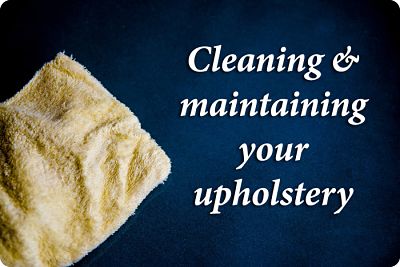Click for Sunbrella Care Click for Vinyl Care Click for Carpet Care Click for Zipper Care
Cleaning & Maintaining Your Clears
RINSE
Your clears are very sensitive to scratching so start by rinsing well (preferably before the salt and grime gets a chance to dry). Rinse with fresh water to remove loose particles and salt, you don’t want to be rubbing grit into your clears.
WASH
For washing make sure you use a clean soft sponge or cloth, no brushes and nothing abrasive, You can use a PH neutral mild soap in water (no detergents or harsh cleansers), once the build-up is removed rinse again and dry with a chamois or microfiber cloth, don’t let them just air dry, this can leave deposits that could turn abrasive later.
POLISH
You really want to maintain the clears topcoat as this holds in the plastisizers and softening agents which keep your clears supple.
Polishing provides that protective coating making it more difficult for the grime to get in so use a plastic conditioner or protector, There are products available from chandleries (Plexus, VuPlex and 303 Aerospace protectant all have great reputations) just make sure you follow the manufacturer’s directions. Another great option here is Mr Sheen, it does a great job. (Just watch your polish near the stitching to ensure no deterioration). If you can manage to polish every 4 – 6 weeks you’ll do yourself a favour and get many years out of your clears, it does get easier as the surface seals itself and less grit seems to stick to them. Keep that surface slick and they will do a much better job of repelling water, dust, salt etc.
EXTRA TIPS:
- Sunscreen lotions and tanning oils will cloud the surface so avoid letting your clears come into contact with them.
- Do not use general house window/glass cleaners, detergents, petroleum-based products, chemical or alcohol products (No methylated or white spirits etc), this can break down the protective elements.
- Do not fold your clears, this can increase your risk of cracks appearing, it is best to leave your clears on so they retain their size and shape, when not in use also try to keep them zippered and clipped on where necessary for the same reason. (Don’t leave them rolled up back at dock).
- Don’t roll or store your clears when wet as this promotes fogging.
Cleaning & Maintaining Your Sunbrella Canvas
To keep your Sunbrella fabric looking good hose off on a monthly basis with clear water, this will help prevent dirt from becoming deeply embedded and reduce the need for more frequent and vigorous cleaning later on, In saying that in most cases and environments a good thorough clean should be carried out every 2 – 3 years.
The directions below come directly from Sunbrella, It’s their product and they know best so we’ll let them do the talking.
GENERAL OR LIGHT CLEANING:
To clean Sunbrella while still on a boat, follow these simple steps: • Brush off loose dirt. • Hose down. • Prepare a cleaning solution of water and mild soap such as Woolite or Dawn dishwashing liquid. • Use a soft bristle brush to clean. • Allow cleaning solution to soak into the fabric. • Rinse thoroughly until all soap residue is removed. • Air dry. • May not require re-treatment depending on the age of the fabric. If stubborn stains persist, you can use a diluted bleach/soap mixture for spot cleaning of mildew. For roof run-off or other similar stains a strong degreaser made be required (see our Stain Chart for specific recommendations).
HEAVY CLEANING FOR STUBBORN STAINS AND MILDEW:
Sunbrella fabrics do not promote mildew growth, however, mildew may grow on dirt and other foreign substances that are not removed from the fabric. To clean stubborn stains: • Prepare a solution of 1 cup bleach and 1/4 cup of mild soap per gallon of clean water. • Soak affected area in solution for 15 minutes. • Blot stain with a sponge or clean towel. (Note: This step should be avoided when cleaning the coated side (Back side) of Sunbrella Plus, Supreme, or Clarity.) • Rinse thoroughly to remove all soap residue. • Air dry. Note: Use caution when cleaning the coated (underside) of Sunbrella Plus, Supreme, or Clarity with the recommended bleach solution. The coated side of the fabric should only be sprayed with the recommended bleach solution and rinsed thoroughly. Remember to protect the area around your Sunbrella fabric if using a bleach solution. Carpet or other fabrics that are not Sunbrella may have an adverse reaction to the bleach.
RE-TREATING THE FABRIC FOR EASE OF CLEANING:
As part of the finishing process, Sunbrella fabrics are treated with a fluorocarbon finish, which enhances water repellency. This finish is designed to last for several years but must be replenished after a thorough cleaning. Based on test results, Glen Raven® recommends 303® Fabric Guard™ as the preferred re-treatment product for Sunbrella fabrics. Fabrics should be retreated after thorough cleaning or as needed. For more information, visit www.303products.com.
APPLYING 303 FABRIC GUARD:
303 should be applied to Sunbrella fabrics after each thorough cleaning, which typically removes the original finish and reduces the fabric’s water repellency. • Clean Sunbrella fabric, using one of the cleaning methods. • Allow Sunbrella to completely air dry. • Apply 303 Fabric Guard in a well-ventilated area following instructions on the container. • Apply 303 in a thin, even coat and allow the fabric to dry completely. • Apply a second thin, even coating of 303. (Two light coatings are more effective in restoring fabric water resistance than a single heavy coating.) Note: A 16-ounce bottle provides coverage of up to 75-100 square feet of fabric depending on material and application method.
PROFESSIONAL CLEANERS:
You may have access to professional cleaning firms. In evaluating the services of a professional firm, you should inquire about a firm’s experience in working with Sunbrella fabrics and knowledge of cleaning and re-treatment requirements.
HELPFUL HINTS:
Protect the area around the Sunbrella fabric when using a bleach solution – bleach may discolour non-Sunbrella fabrics. Always rinse Sunbrella thoroughly to completely remove bleach. Please be aware of the environment when cleaning with bleach. Bleach can have harmful effects on the natural environment around you. We do not advise using bleach if you are surrounded by a body of water or other environments that could be affected. Sunbrella should only be allowed to air dry. Use of bleach and/or advanced age of the fabric application may impact the deterioration of the sewing thread and other non-Sunbrella components.
Check out this write-up on our blog for more detailed Sunbrella Cleaning Charts.
Cleaning and Maintaining your Vinyl
Firstly, to keep your vinyl seats and cushions in great condition it’s important you try to keep them as clean as possible in the first place, they need to breathe and they need to ventilate moisture. When moisture becomes trapped you encourage mould and mildew. If you give your seats a clean between uses you’ll be all the better off.
Marine vinyl is designed to resist mould, unfortunately its not perfect and has not been manufactured to withstand accumulated sunscreen, tanning lotions or dirt than can clog the pores.
GENERAL CLEANING
After a day on the water, clean your seats and cushions with mild detergent and clean water or a commercially made vinyl cleaner from a chandery (using a soft bristle brush for stubborn grime), then rinse and dry. Pay extra attention to piped edges, where pore-clogging dirt collects – you may want to use a toothbrush or nailbrush to clean these areas. Make sure to rinse away any excess cleaning solutions and thoroughly dry.
Always use non-toxic cleaners for vinyl. Cleaning products containing chlorine, alcohol and/or ammonia will chemically dry your vinyl and promote premature cracking and peeling, while greasy cleaners, dressings, and gloss-promoting products will clog the pores and seal-in existing dirt.
Some people use bleaches but this is too harsh for the vinyl and will cause it to break down over time, you also run the risk of bleaching other fabrics or carpets on your boat so steer clear. Bleach will also deteriorate the stitching.
MOULD & MILDEW
When you do get mould there are options, what you need to remember is many cleaners will get rid of the mould short term, if you do not kill the spores the mould will return again and again.
Magic Eraser often works quite well at removing stains from the surface of marine vinyl. Before using specialised cleaners, try scrubbing the stain with water and a Magic Eraser pad. Use care when scrubbing. Do not scrub off or sand down the vinyl.
Mix a solution of Mould & Mildew Stain Remover as per instructions (IOSSO Mold & Mildew Stain Remover is a recommended product). Wet the area with the mix then let soak for about 15 minutes. Scrub the area with a sponge or soft cloth. For stubborn stains try using a Magic Eraser to scrub the stain off.
For mould prevention, a mixture of 1/2 tsp clove oil in 1 ltr of water will kill the spores (Not just clean up the mould, although it will do that too). Spray the mixture on and leave for 20 minutes then wipe off. You can then give it another light spray and leave to dry. To keep mould growth under control try to carry out the method every 12 – 16 weeks.
To kill mould you can also use a 50/50 mix of white vinegar and water along with baking soda, sprinkle on the baking soda and wash with the vinegar solution.
Cleaning & Maintaining Your Carpets
This section is pretty straight forward, There are quite a few options as with cleaning most general carpets.
A high pressure water gun is a great option, some people use a carpet cleaning solution (vinegar works well), scrub it in then rinse with the high pressure cleaner, some people go to a car wash and use the water and soap guns there. Make sure you use from a distance though, getting right up close can damage the adhesives holding your carpet down.
You can also opt for a wet dry vac, if you don’t have one the supermarket hire ones are great and easy to use. This way you can pull the water back out after cleaning.
If you don’t have any of the above some sugar soap and good old fashioned elbow grease will do it, use your regular hose and then run across your carpet with a good piece of round edge pine wood, use it as a squeegee and push out any remaining water.
Cleaning and Maintaining your Zippers
Another quick and easy section, you want your zippers to work well, there’s not much point to them if they are stuck and don’t slide so try the following for hassle free zips and sliders.
Keep them moving, this will help to prevent salt and dirt hardening and ceasing up your zippers, Also make sure to rinse salt water off after you’ve been out to halt corrosion. Plastic zippers actually contain a built in lubricant so keep them moving and the plasticizer in the plastic will come back to the surface. (If the surface hasn’t become damaged).
If you feel its necessary use a lubricant, Ideally use a dry silicon or water based lube, candle wax or bees wax.
If you have stuck and corroded zippers try hot water and vinegar to dissolve the oxide/salt and free the zipper. As with everything else just keep everything clean and rinsed, prevention beats solving the problem later.




